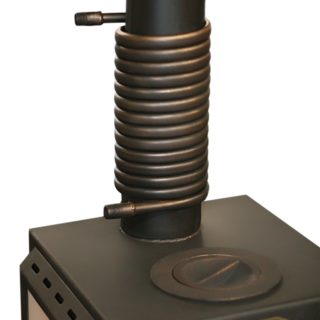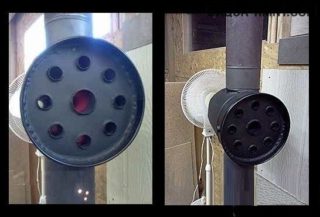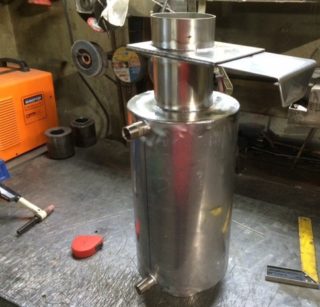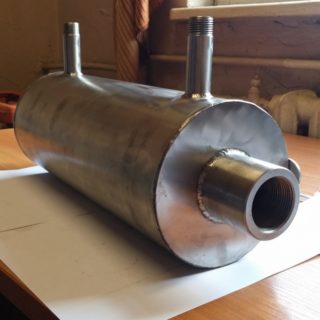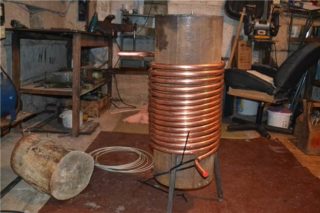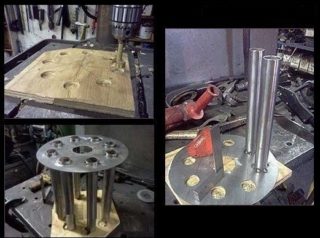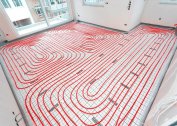A feature of stove heating is a large amount of heat released into the atmosphere. You can reduce the cost of buying firewood and coal by installing a heat exchanger on the chimney pipe. Specialized stores offer recuperators suitable for different operating conditions. Simple devices are made by hand.
Device purpose
Up to 40% of the heat generated during the combustion of fuel in stoves does not fulfill its purpose. Through the draft, hot gases enter the atmosphere through a chimney. In this case, the metal channels of the outlet are very hot.
The case of the recuperator, which does not heat up so much, protects against burns when accidentally touched.
Using a heat exchanger, part of the energy is put into operation by heating air, water or antifreeze in the heating system.
Work principles
Only a heat exchanger mounted on a metal pipe is considered effective. The outer surface of brick chimneys does not heat above 40 degrees, so you can not get a lot of heat from them.
The device operation algorithm is simple:
- hot gases passing through the pipe heat it;
- heat is transferred from the outer surface of the chimney to the heat carrier - water, air, antifreeze;
- the heat carrier transfers heat to the room.
Recuperators of various designs transfer thermal energy from the combustion products to the coolant.
Manufacturers and sellers divide the devices into two types depending on the physical environment that transfers energy: air and water. Devices use natural and forced circulation of the coolant.
Air heat exchangers
The principle of convection is used in the work.
There are several varieties of devices.
- The flow of combustion products is divided and rises through several tubes. Large surface area accelerates heat transfer processes.
- Several tubes are welded to the main channel. Due to convection, the air in the room passes through the heat exchanger, heating up, rises through the tubes.
- Around the main pipe is a larger diameter pipe, to which the inlet and outlet channels are fixed. Using the device, you can heat the rooms located in the vicinity of where the stove is located.
- Metal ribs forming channels are welded to the central pipe. In this way, the area involved in heat transfer and accelerating convection is increased.
- A variant of the bell-type furnace. Hot gases rise through the heat exchanger and heat the air. Cooling, the vapor falls down the hood and discharged into the atmosphere.
Industrial-made air heat exchangers are easy to obtain at specialized retailers. Products are produced with standard mounting diameters. Install such devices instead of one section of the chimney.
If the exhaust pipe is made to non-standard sizes, the chimney heat exchanger can be easily manufactured independently. The strength of any home master.
The price of factory fixtures is high - this is the second argument in favor of the independent manufacture of a heat exchanger.
To work, you will need tools:
- welding machine and face shield:
- angle grinder (grinder) with cutting and grinding wheels;
- drill with a set of drills and crowns for metal;
- tape measure, ruler, protective equipment (gloves, glasses).
Depending on the chosen design, they are selected from existing stocks or purchased metal strips or corners, steel plates.
For work it is undesirable to use galvanized steel. When heated to high temperatures, harmful zinc compounds are released into the air.
Simple homemade designs
The simplest and most affordable version of the air heat exchanger for the chimney are fins welded to the main pipe. Work will take no more than an hour.
As a material suitable:
- pieces of a corner or plate of metal;
- profile or round pipe.
The whole process consists in cutting parts of equal length and welding them to the chimney pipe.
The heat exchanger should not "take" all unused heat - condensate, carbon deposits form in the insufficiently hot pipe, and the draft decreases.
Limits the use of home-made models unattractive appearance. If design decisions are not required (garage, workshop, bath), models successfully cope with the task.
For more complex options, when the gas flow is divided into several tubes, it is necessary to have professional welder skills - the leak of carbon monoxide through unevaluated places is deadly, smoke will not allow you to comfortably be indoors.
In cases where accurate and beautiful designs are required, it is better to contact trade organizations and purchase the finished product.
For the manufacture of nickel-plated parts or stainless steel heat exchangers, you will need expensive material, work skills and special equipment for spot welding.
Water models
In water heat exchangers, the medium of energy transfer from the pipe is liquids - water or antifreeze in heating systems or clean water for household needs.
There are two designs:
- in the form of a coil connected to a storage tank;
- "Samovar" designs.
In the first case, several turns of a copper, aluminum or stainless tube are wrapped around the pipe, which lead to the drive.
The coil can be in airspace or inside an additional tank. The second option involves a sealed container located around a metal chimney. The fittings for supplying and discharging heated fluid are welded to the tank.
Due to the laws of physics, the water heated in the heat exchanger rises into a remote storage tank. Be sure to arrange a circulation loop. If it is not done, the water will heat up the heat exchanger.
Warm water is taken from the tank. A drain valve is needed to remove water if the room is not constantly heated. At low temperatures, defrosting of all parts of the structure may occur.
Having added a circulation pump and a safety group to the circuit, one, at most two heating radiators is connected to the heat exchanger. This design is enough for heating a one-room premise.
The heat exchanger of the solid fuel stove does not heat the country house. Large heat dissipation leads to cooling of the pipe and reduced traction.
How to do it yourself
The manufacture of "samovar" design is trusted by professionals or buy the finished product in the store.
To avoid leaks at the seams, you need skills in welding.
Metal is welded by gas welding - electric welds are unsuitable for durable operation in systems filled with liquids.
Self-made heat exchanger in the form of a coil for hot heat supply.
From the materials you will need:
- copper or aluminum tube with a diameter of up to 25 mm;
- a tank with a float mechanism for supplying liquid from a water supply pipeline;
- flexible eyeliner;
- ball valve.
The total length of the tube for the natural circulation of water should not exceed 3 meters.If the part is longer, install a circulation pump in front of the heat exchanger.
Work sequence:
- At the ends of the tube, threads are cut to connect the fittings.
- The pipe is wound around a shape of the same radius as the chimney. If the cross section of the tube is small, it is filled with sand. This will prevent creases and overlaps of the internal section.
- Install the finished coil in the chimney.
- Hang the heat exchanger tank on the wall, but not higher than 50 cm from the hot water outlet fitting from the coil.
- Make connections.
It is simpler to execute, but more expensive is the option when a flexible corrugated stainless tube is used to make a spiral. Buy corrugation with already mounted fittings. This will facilitate installation, you will not have to purchase a special tool to install the connectors.
A chimney heat exchanger bought or made with your own hands will save money on the purchase of fuel and add comfort to a country house, bathhouse, garage. Devices quickly pay off, while homemade devices are inexpensive. Installation does not require great skills, while the benefits of the device are great.
